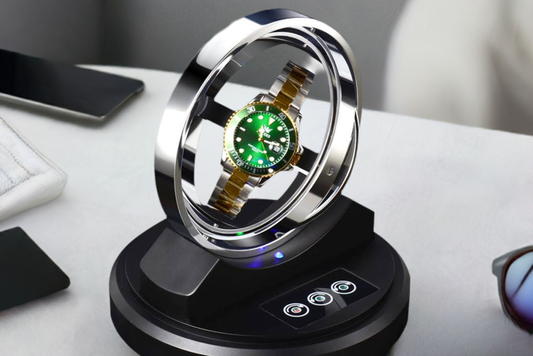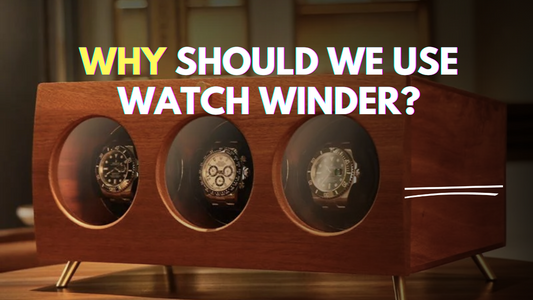Rolex watches have long been synonymous with precision, reliability, and timeless elegance. From the groundbreaking Perpetual Rotor to the absence of batteries, Rolex has consistently pushed the boundaries of watchmaking, creating timepieces that are as much a work of art as they are a functional tool.
The Perpetual Movement: A Revolution in Timekeeping
Rolex's Perpetual Movement, introduced in 1931, revolutionized the world of watchmaking. This innovative self-winding mechanism harnesses the wearer's natural movements to keep the watch running, eliminating the need for manual winding or batteries. The Half-Moon Oscillating Weight, a critical component of the Perpetual Movement, captures even the slightest motion, ensuring a constant and reliable power source.
Credit: YouTube Channel - Animagraffs
The Mechanics of a Rolex: A Symphony of Precision
At the heart of every Rolex beats a meticulously crafted mechanical movement. The smooth sweep of the seconds hand, the intricate dance of gears and springs, and the mesmerizing oscillations of the balance wheel all work in harmony to keep time with unparalleled accuracy. From the robust mainspring to the delicate escapement, each component is a testament to Rolex's unwavering commitment to horological excellence.
Setting and Winding Your Rolex: A Guide for Owners
Owning a Rolex is a privilege, and understanding how to properly set and wind your timepiece is essential. Whether you have a manual-wind or automatic model, following a few simple steps will ensure your Rolex remains accurate and functional for generations to come. Regular maintenance, such as servicing every 5-10 years and avoiding exposure to extreme temperatures and magnetic fields, will help preserve your Rolex's longevity and value.
Rolex vs. Quartz: The Allure of Mechanical Timekeeping
In an age of quartz watches, Rolex remains steadfast in its dedication to mechanical movements. While quartz timepieces offer convenience and affordability, they lack the soul and craftsmanship that define a Rolex. The tactile experience of a mechanical watch, the emotional connection it fosters, and the investment potential it holds all contribute to the enduring appeal of a Rolex.
Rolex's Legacy: A Timeless Tradition of Innovation
From the earliest days of the Oyster case to the cutting-edge materials and technologies employed today, Rolex has always been at the forefront of horological innovation. The brand's pioneering spirit has given birth to iconic models like the Submariner, the Daytona, and the GMT-Master, each with its own unique story and place in watchmaking history.
Embrace the Rolex Experience
To truly appreciate the magic of a Rolex, one must experience it firsthand. The weight of the watch on your wrist, the satisfying click of the winding crown, and the mesmerizing dance of the seconds hand all contribute to the Rolex experience. Whether you're a seasoned collector or a first-time owner, a Rolex is more than just a timepiece – it's a symbol of achievement, a companion through life's moments, and a legacy to be passed down through generations.
We invite you to share your own Rolex stories and experiences in the comments below. What drew you to the brand? Which model holds a special place in your heart? How has your Rolex been a part of your life's journey? Let's celebrate the timeless tradition of Rolex together.
Frequently Asked Questions
Do Rolex watches require batteries?
No, most Rolex watches do not require batteries. Rolex primarily produces mechanical watches that are powered by either manual winding or automatic self-winding movements. The only exception is the Rolex Oysterquartz, a quartz watch produced by Rolex from the 1970s to the early 2000s.
How often should I service my Rolex?
Rolex recommends servicing your watch every 5-10 years, depending on the model and your usage. Regular servicing ensures your Rolex remains accurate and functional, and helps maintain its value over time. During a service, a Rolex-certified technician will disassemble, clean, lubricate, and reassemble your watch, replacing any worn or damaged components.
Can I wear my Rolex while swimming or diving?
Most modern Rolex watches are water-resistant to depths of at least 100 meters (330 feet), with some models, like the Rolex Submariner and the Rolex Sea-Dweller, designed specifically for diving. However, it's essential to have your watch's water resistance tested annually and after any repairs or maintenance to ensure its integrity.
How do I know if my Rolex is authentic?
Authenticating a Rolex can be a complex process, as counterfeiters have become increasingly sophisticated. Some key factors to consider include the quality of the materials, the precision of the engravings, the smoothness of the second hand's sweep, and the presence of genuine Rolex packaging and documentation. The best way to ensure your Rolex is authentic is to purchase from an authorized Rolex retailer or a reputable pre-owned dealer and to have the watch authenticated by a professional.
What is the power reserve of a Rolex watch?
The power reserve of a Rolex watch varies depending on the model and movement. Most modern Rolex watches, such as those equipped with the Calibre 3135 or the Calibre 3235, have a power reserve of approximately 48 hours. Some newer models, like the Rolex Calibre 3255 found in the Day-Date 40, boast a power reserve of 70 hours. This means that once fully wound, the watch will continue to run accurately for the specified period without additional winding.




